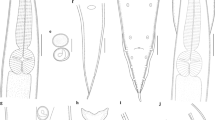Summary
Identification of the nematode Xiphinema italiae relies mainly on time-consuming morphological and morphometrical studies. A polymerase chain reaction protocol has been used for the reliable and specific identification of X. italiae. Moreover, four independently evolving molecular markers (cox1- cytochrome c oxidase subunit 1; ITS2-second internal transcribed spacer; 18S gene and D2/D3 expansion segments of 28S gene) were amplified and sequenced in both directions.
Similar content being viewed by others
Reference
Barsi, L., Lamberti, F. (2003): Morphometrics of adults and juvenile stages of three longidorid nematodes (Nematoda: Dorylaimida) from Vojvodina Province, Northern Serbia. Nematol. Medit., 31: 65–85
Brown, D. J. F., Boag, B. (1988): An examination of methods used to extract virus-vector nematodes (Nematoda: Longidoridae and Trichodoridae) from soil samples. Nematol. Medit., 16: 93–99
Cohn, E., Tanne, E., Nitzany, F. E. (1970): Xiphinema italiae, a new vector of grapevine fanleaf virus. Phytopathology, 60: 181–182
de Ley, P., Félix, M. A., Frisse, L. M., Nadler, S. A., Sternberg, P. W., Thomas, W. K. (1999): Molecular and morphological characterisation of two reproductively isolated species with mirror-image anatomy (Nematoda: Cephalobidae). Nematology, 1: 591–612
Derycke, S., Remerie, T., Vierstraete, A., Backeljau, T., Vanfleteren, J., Vincx, M., Moens, T. (2005): Mitochondrial DNA variation and cryptic speciation within the free-living marine nematode Pellioditis marina. Mar. Ecol. Prog. Ser., 300: 91–103
Dias-Silveira, M.F., Herrera, J.O. (1995): Principales problemas nematologicos en Cuba. In: Congresso International de Nematologia Tropical, Rio Quente, Brazil. Proceedings, 161–171
He, Y., Jones, J., Armstrong, M., Lamberti, F., Moens, M. (2005a): The mitochondrial genome of Xiphinema americanum sensu stricto (Nematoda: Enoplea): Considerable economization in the length and structural features of encoded genes. J. Mol. Evol., 61: 819–833
He, Y., Subbotin, S. A., Rubtsova, T. V., Lamberti, F., Brown, D. J. F., Moens, M. (2005b): A molecular phylogenetic approach to Longidoridae (Nematoda: Dorylaimida). Nematology, 7: 111–124
Holterman, M., Wurff, A. V. D., Elsen, S. V. D., Megen, H. V., Bongers, T., Holovachov, O., Bakker, J., Helder, J. (2006): Phylum-wide analysis of SSU rDNA reveals deep phylogenetic relationships among nematodes and accelerated evolution toward crown clades. Mol. Biol. Evol., 23: 1792–1800
Khan, F. A., Erinle, I. D., Chindo, P. S. (1993): Survey of plant parasitic nematodes associated with grapevine in 4 northern states of Nigeria and observations on grapevine fanleaf virus. J. Afr. Zool., 107: 505–510
Knoetze, R., Burger, J. T, Meyer, A. J. (2000): Discrimination of some Xiphinema species from South Africa by rDNA-RFLP analysis. Afr Plant Protect., 6: 25–30
Kumari, S., Decraemer, W., Traversa, D., Lišková, M. (2009): Molecular and morphological delineation of Longidorus poessneckensis Altherr, 1974 (Nematoda: Dorylaimida). Eur. J. Pl. Path., 123: 125–137
Lamberti, F., Agostinelli, A., Radicci, V. (1996): Longidorid nematodes from Northern Egypt. Nematol. Medit., 24: 307–339
Lazarova, S. S., Malloch, G., Oliveira, C. M. G., Hübschen, J., Neilson, R. (2006): Ribosomal and mitochondrial DNA analyses of Xiphinema americanum-group populations. J. Nematol., 38: 404–410
Lišková, M. (1996): The males of Longidorus leptocephalus and Xiphinema italiae (Nematoda: Longidoridae) from Slovakia. Helminthologia, 33: 87–92
Liskova, M., Brown, D. J. F., Taylor, C. E. (1995): The occurrence and distribution of Longidoridae and Trichodoridae in the Slovak Republic. Rus. J. Nematol., 3: 49–60
Liskova, M., Lamberti, F., Sabová, M., Valocká, B., Agostinelli, A. (1993): First record of some species of longidorid nematodes from Slovakia. Nematol. Medit., 21: 49–53
Martelli, G. P., Cohn, E., Dalmasso, A. (1966): A redescription of Xiphinema italiae Meyl, 1953 and its relationship to Xiphinema arenarium Luc et Dalmasso, 1963 and Xiphinema conurum Siddiqi, 1964. Nematologica, 12: 183–194
Nagy, P. (1999): New faunistic record for Longidorus attenuatus Hooper, 1961 and Xiphinema italiae Meyl, 1953 (Nematoda: Longidoridae) in Hungary. Növényvédelem, 35: 15
Oliveira, C. M. G., Fenton, B., Malloch, G., Brown, D. J. F., Neilson, R. (2005): Development of species-specific primers for the ectoparasitic nematode species Xiphinema brevicolle, X. diffusum, X. elongatum, X. ifacolum and X. longicaudatum (Nematoda: Longidoridae) based on ribosomal DNA sequences. Ann. Appl. Biol., 146: 281–288
Peneva, V., Choleva, B. (1992): Nematodes of the family Longidoridae from forest nurseries in Bulgaria. II. The genus Xiphinema Cobb, 1913. Helminthology, 32: 46–58
Polinovskij, A. I. (1979): Species composition and geographic distribution of nematodes of the family Longidoridae (Nematoda: Dorylaimoidea) on grapevines of the Moldavian SSR, USSS. Izv. Akad. Nauk Mold. SSR. Ser. Biol. chim. Nauk, 11: 37–48
Romanenko, N. D. (1985): Distribution of Longidoridae nematodes in fruit and berry plantations in the USSR. In: Progressive methods of soft fruit cultivation and breeding. Sbornik Nauch. Trud. Moscov, 112–120
Siddiqui, Z. A., Rashid, A., Farooqi, N., Bisheya, F. (1987): A survey of plant parasitic nematodes associated with citrus in Libya and trials on chemical control. Indian J. Nematol., 17: 76–80
Stanton, J. M., Mcnicol, C. D., Steele, V. (1998): Non-manual lysis of second-stage Meloidogyne juveniles for identification of pure and mixed samples based on the polymerase chain reaction. Australas. Plant Path., 27: 112–115
Teliz, D., Landa, B. B., Rapoport, H. E., Camacho, F. P., Diaz, J. R. M., Castillo, P. (2007): Plant parasitic nematodes infecting grapevine in southern Spain and susceptible reaction to root-knot nematodes of rootstocks reported as moderately resistant. Plant Dis., 91: 1147–1157
Tzortzakakis, E. A., Pateras, D., Charoulis, A. (2006): Occurrence of Xiphinema species in grapevine areas of Tyranvos with comments on the distribution of X. italiae in Greece. Helminthologia, 43: 186–187
Wang, X., Bosselut, N., Castagnone, C., Voisin, R., Abad, P., Esmenjaud, D. (2003): Multiplex polymerase chain reaction identification of single individuals of the longidorid nematodes Xiphinema index, X. diversicaudatum, X. vuittenezi, and X. italiae using specific primers from ribosomal genes. Phytopathology, 93: 160–166
Author information
Authors and Affiliations
Corresponding author
About this article
Cite this article
Kumari, S., Lišková, M. Molecular confirmation of Xiphinema italiae Meyl, 1953 (Nematoda: Longidoridae) from the Slovak Republic. Helminthologia 46, 131–134 (2009). https://doi.org/10.2478/s11687-009-0025-8
Received:
Accepted:
Published:
Issue Date:
DOI: https://doi.org/10.2478/s11687-009-0025-8




